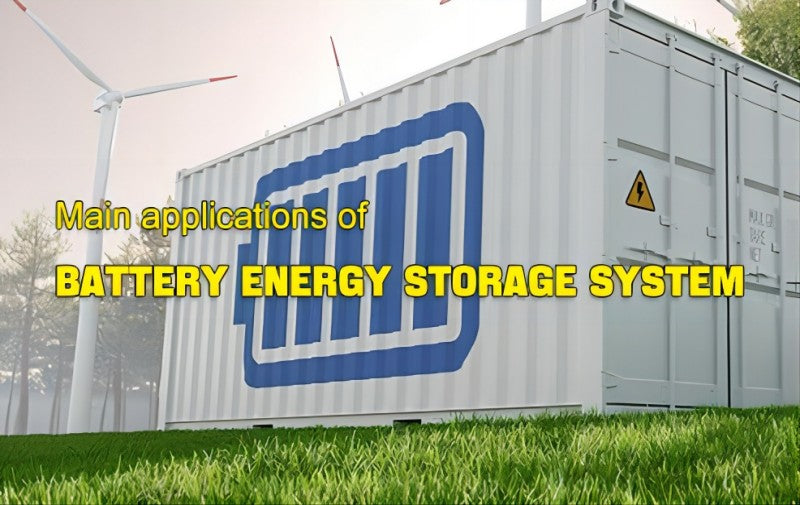
Main content:
In recent years, with the continuous maturity of various power generation technologies, the daily electricity consumption of residents and the large-scale electricity consumption of factories and companies have been well guaranteed. The volatility of new energy power generation leads to unbalanced power supply, resulting in the waste of some power.
Therefore, power storage in power systems has become a hot spot of widespread concern. Many types of electrical energy storage systems have been designed, such as battery energy storage, superconducting energy storage, supercapacitor energy storage, and pumped water energy storage.
Compared with other energy storage methods, battery energy storage system is more suitable for application in power systems due to their safety, mature technology, convenient installation and no pollution.
The battery energy storage system can assist the thermal power unit to improve the AGC level, shortening its response time from minutes to seconds. The battery energy storage system can assist new energy grid connection, while improving the new energy consumption capacity of the grid, it can also stabilize the fluctuation of new energy output.
The battery energy storage system can undertake the function of independent frequency regulation, further reducing the frequency fluctuation range of the power grid, and improving the power supply quality of the power grid. The energy storage system can also be used as the main power supply of the micro-grid, and effectively bring light and civilization to areas without electricity.
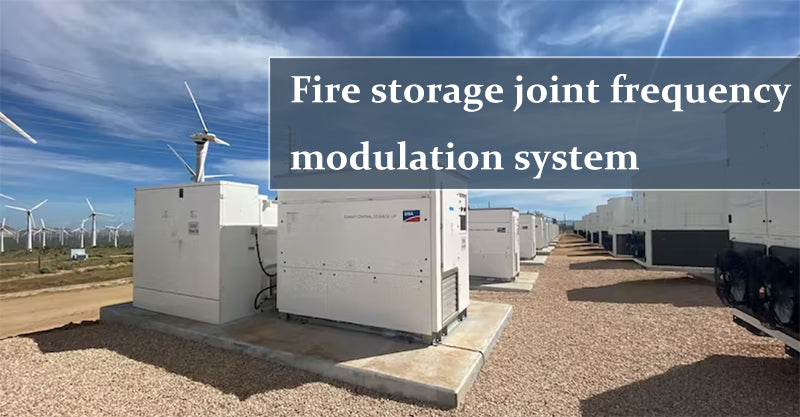
Fire storage joint frequency modulation system
As the main frequency regulation resource for AGC auxiliary services, thermal power units have the disadvantages of long response time, generally on the order of tens of seconds, slow adjustment rate, and the standard adjustment rate (MW/min) of thermal power units does not exceed 3% of the rated power. The adjustment accuracy is poor, and the allowable deviation of the thermal power unit is 1% of the rated power.
The use of battery energy storage system and thermal power unit to respond to AGC commands can give full play to the characteristics of short response time (<100ms), fast adjustment speed (no-load to full-load adjustment time is less than 20ms) and high adjustment accuracy of the battery energy storage system. While improving the unit regulation performance index as a whole, the project can obtain better economic benefits.
The basic principle and process of fire-storage joint frequency modulation:
- Electrically realize the parallel operation of battery energy storage system and thermal power units at the grid-connected end, and work together to track AGC dispatching instructions, so that the overall regulation performance is greatly improved;
- On the premise of not changing the original AGC control of the thermal power unit, the battery energy storage system output command is constructed based on the difference between the AGC command and the real-time output of the thermal power unit, and the fast and precise power control characteristics of the energy storage system are used to make up for the difference caused by the difference power demand gap;
- As the output of the thermal power unit responds to and approaches the AGC command, the output of the battery energy storage system is withdrawn accordingly, until finally the thermal power unit assumes the output of the AGC command.
It can be seen that during the single AGC adjustment process, the battery energy storage system works at high power and the time is on the order of 1 to 2 minutes.
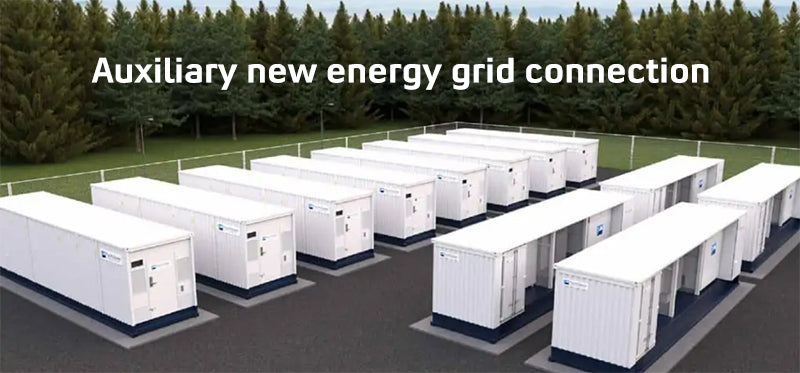
Auxiliary new energy grid connection
Due to the strong randomness, volatility and indirectness of wind power, photovoltaic and other new energy power generation. Therefore, after a high proportion of new energy is connected to the power system, it will lead to a substantial increase in power generation fluctuations, increasing the difficulty of maintaining a balance between power supply and demand.
The battery energy storage system can track the output plan of new energy power generation. When the output is low, the battery energy storage system outputs power, and when the output peaks, the battery energy storage system absorbs power. Through hour-level energy storage and release, it realizes peak-shaving and valley-filling of power grid loads, relieves the peak-shaving pressure of conventional units, and fully utilizes the ability of the existing power grid to accept new energy.
The combination of energy storage and new energy power generation mainly starts from three aspects: peak shaving and valley filling, improving power generation prediction accuracy and planning, and smoothing short-term fluctuations.
- Cut peaks and fill valleys
New energy power generation, long-term fluctuations in a day and mismatch of load and consumption will increase the system's demand for up and down reserve capacity. Peak shaving and valley filling is to use the time-translation characteristics of energy storage to energy, to maximize the use of line transmission capacity and match the trend of load power consumption, while reducing the need for conventional units to increase and decrease capacity.
- Improve prediction accuracy
At present, the short-term power prediction curve accuracy of most wind and light power prediction systems exceeds 80%, and the average deviation is calculated according to ±10%. Configuring energy storage with 10% capacity can stabilize the power prediction error.
- Smooth short-term fluctuations
The short-term change rate of new energy power generation should also meet the stability requirements of the power system. The battery energy storage system can be used to store and release new energy power generation, and suppress the minute-level power fluctuations of the new energy grid-connected system.
Due to the various functions of the battery energy storage system when new energy is connected to the grid, provinces across the country have successively introduced mandatory requirements for new energy distribution and storage. The configuration of energy storage has a positive effect on solving the high proportion of new energy consumption and improving the stability of the grid.
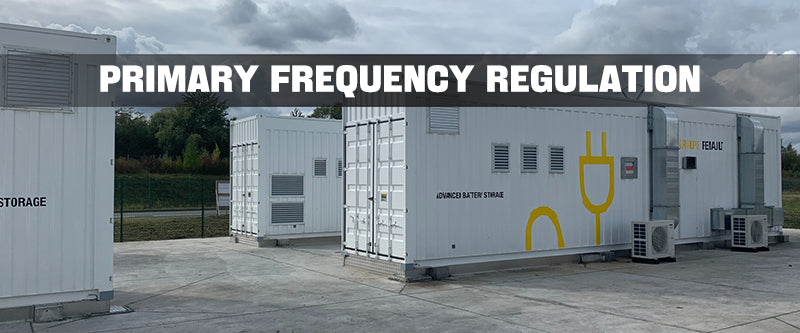
Primary frequency regulation
Primary frequency regulation is mainly to cope with short-term rapid load fluctuations. Specifically, once the frequency of the power grid deviates from the rated value, the control system of the unit in the power grid will automatically control the increase or decrease of the active power of the unit, limit the change of the power grid frequency, and make the grid frequency maintain a stable automatic control process.
The power grid has different requirements on the primary frequency regulation performance of different types of generator sets. For example, the primary frequency regulation control dead zone of a thermal power plant is (50±0.033) Hz, and a photovoltaic power station is (50±0.06) Hz. Using its fast and accurate power grid frequency detection and power control capabilities, the battery energy storage system can respond to grid frequency changes faster than thermal power units, and independently undertake primary frequency regulation capabilities.
According to the assessment of the double detailed rules of the power grid, adding battery energy storage systems to new energy power stations can complete or improve the functions of peak regulation, primary frequency regulation and AGC dispatching, etc. One-time frequency regulation can reflect and exert the rapid power climbing performance of the power-type energy storage system, and the capacity demand is limited.
AGC scheduling is equivalent to the secondary frequency regulation function of the power grid. If new energy power generation forecasting, energy storage technology and the third frequency regulation of the power grid are combined, on the one hand, the adjustable predictability and dispatchability of new energy grid connection can be improved, and at the same time, the reserve capacity of conventional generating units can be released, greatly improving the power reserve or inertia support capacity of the grid at the 15min level.
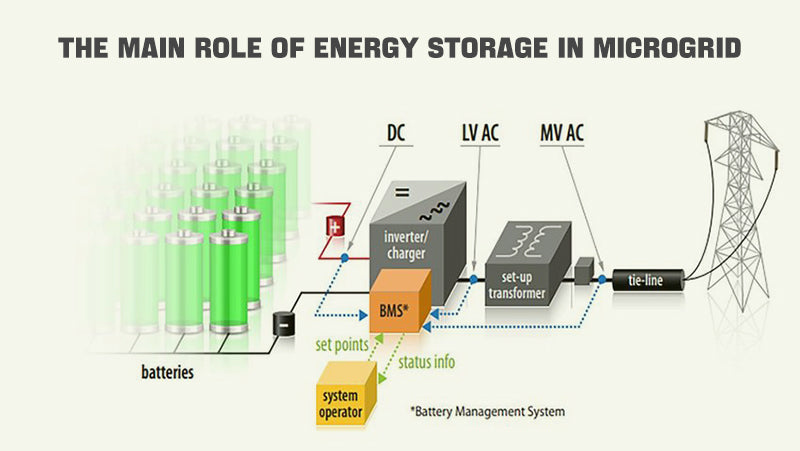
The main role of energy storage in microgrid
Microgrid, also known as microgrid, refers to a small power generation and distribution system composed of distributed power sources, energy storage devices, energy conversion devices, loads, monitoring and protection devices, etc. It is a main form of battery energy storage system applied on the user side, and it is also an important technical solution to improve the power supply quality of weak grids and realize power supply in areas without electricity.
According to the relationship with the large power grid, the microgrid has two modes: off-grid and grid-connected. Among them, the battery energy storage system always undertakes important functions such as energy instantaneous balance and voltage stability. The main role of energy storage in microgrid:
- Improve the stability of distributed energy
The battery energy storage system is applied to the microgrid. Through the energy management system (EMS), the distributed energy, the battery energy storage system, and the main power grid are controlled in coordination, which can stabilize the fluctuation of the distributed energy, stabilize the output, and provide local distribution of the distributed energy.
In addition, the battery energy storage system can continue to provide partial power to the main load at night or during maintenance of distributed energy sources, reducing power outage time.
- Improve the power quality of users' electricity consumption
When the microgrid is connected to the main grid and operated in parallel, its power quality must meet the relevant standards, that is, parameters such as power factor, voltage asymmetry, current harmonic distortion rate, and voltage flash drop must reach corresponding values.
In the absence of an battery energy storage system, the microgrid cannot guarantee the power quality, especially the voltage stability, due to the unstable characteristics of its own new energy. The application of the battery energy storage system can play an important role in improving the power quality of the microgrid.
Through the control of the PCS in the battery energy storage system, the system can adjust the active and reactive power output from the battery energy storage system to the microgrid while stabilizing the output of electric energy. At the same time, it solves the problem of voltage sag/drop.
- Peak-valley spread arbitrage
In the microgrid, the battery energy storage system can store the excess energy generated by distributed energy sources when the load is low, release the energy during the peak load, and adjust the load demand. The often-called peak-valley price difference arbitrage is through the low-voltage power grid at night. Charge the battery energy storage power station and discharge it during the peak power consumption during the day to achieve the purpose of saving electricity costs and obtaining benefits.
Summary
With the vigorous development of the new energy industry, the energy storage industry has become one of the hot spots that have attracted the most attention this year. In the future, a large proportion of renewable energy will be connected to the power system has become the general trend.
The development of energy storage will be an important support for maintaining the safety and stability of the entire power system, which also brings huge opportunities for the development of the energy storage industry.
Related article: offshore wind power, new energy storage technology, commercial energy storage companies